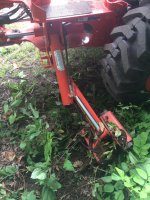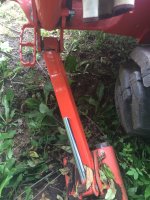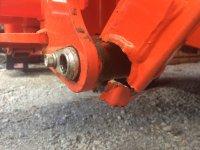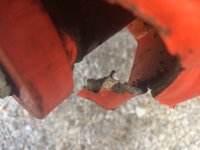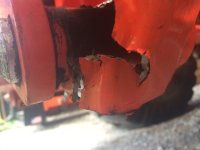I would prefer to see 1/4" steel tube used, as well a brace or wider piece of tube to resist bending as easy. May be something I can fab up to ensure it doesn't happen again. Going to need to invest in a bigger welder I think.
I'm sorry that happened, but thankful no one was hurt, and that you shared it with the group.
I'm also sorry for the long-ish post, but I believe many will be rather interested at the theory I float at the end (which I
hope I'm wrong about...).
I'm no metallurgist, but I too (as have others) thought I saw rust in the weld--though it may just be dirt/mud. If rust, I agree, could have been a poor weld, partially cracked already.
And not to be the "Safety/Legal Police", nor to belabor the obvious, but if you weld
anything on the (new) pieces that (I EXPECT) Kubota is going to install on your machine, of course, any future failures (to that part, and/or any damages/bodily injury that can be possibly be found to be "proximately caused"
by the failure of a part you modified) WILL be blamed on your (uncertified?) welding/modifications. It's not (necessarily) fair, I know, but that's how corporate lawyers make their bread.
So, especially since this is the first we've seen of this type of failure,
I would suspect bad metallurgy/welding, and I would NOT plan on modifying things myself, were I you, both to avoid being blamed for any future failures and because, again, since this is not a known failure, I respectfully submit that the stabilizers may be just fine, as is, IF properly welded, and, of course, with sound base metal. Just my .02.
Your dealer sounds very responsive, which is great! If things turn sour (which I doubt they will), however, I assume there are "Zone Reps," as there are in the auto-biz, which you can also ask to speak with. And Kubota Corporate, themselves, whose representatives I have found willing to pick up the phone and answer far less serious questions than yours.
Just curious--year tractor went into service? Hours on the tractor/hoe?
Oh--and did you have the rear tires off the ground (as we see commercial operators doing, commonly)? Or were they lightly on the ground which, IIRC, my
BH77 Operator's Manual recommends, which kind of surprised me, given how the "Big Boys" operate their (commercial) machines.
Whoops--one more question:
are your rear tires filled, or not? The reason I ask is, as I'm sure you know (and again, IIRC), Kubota recommends NOT running filled tires while operating the BH. (As if we've all got a second set of rear wheels lying around, and the time/equipment/strength to change them back-and-forth.)

I ask because
I HOPE you haven't accidentally discovered the answer to the long-debated question of WHY Kubota doesn't want the hoe operated with filled tires. Again, with the assumption that the (HEAVIER, FILLED tires) would be lifted off the ground, by the stabilizers--which again, IIRC, the
BH77 Manual says NOT to do. (And IF this is the reason,
then you would be absolutely correct, as you stated, about your theory that square-tube stock of the stabilizers should be thicker than it apparently is....)
Good luck, and let us know.
My Hoe
